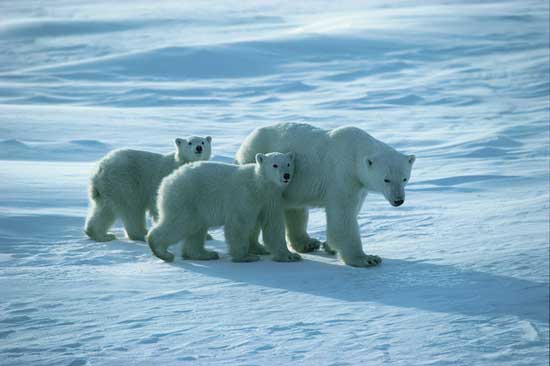
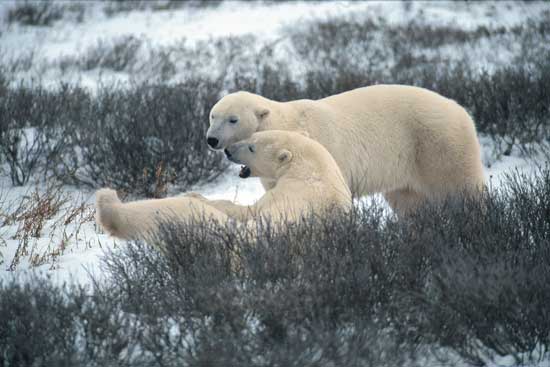
Polar bears are everywhere these days. Peering at you from cans of Coke, eating ice cream in ads, and padding around in cartoon arctics with penguins (who belong at the other pole).
Polar bears are everywhere. Everywhere, that is, but where they should be: On ice floes in the far, far north.
The world’s largest land carnivores are in trouble. Since they live and hunt part-time on frozen chunks of ocean, declines in sea ice could cut back their numbers by two thirds by 2050. Or worse. They could become extinct.
To me this shot up a flare of alarm. I wanted to write checks to charities who would try to help them. I wanted to buy bear books. I wanted to spend hours at the zoo.
The more I read and watched, the more I realized: It didn’t work.
I needed to see these big white guys in the wild before it was too late.
* * *
It is October, late in the month, and I sign up for a tour to the not-quite-North Pole. It is a safari, a weird one, run by Natural Habitat Adventures. Instead of lions or elephants or leopards, we will be aiming for bear. Polar bears, that is–those that are roaming the sub-arctic tundra near an outpost called Churchill, Manitoba.
When I look at a map, I note that the Arctic Circle is at latitude 66.6. Churchill, on the edge of Hudson Bay, sits at 60. I buy myself a hat with ear flaps. In a basement box I turn up a pair of boot socks. The kind that are as thick as mittens. The kind that take up all the room in your shoes.
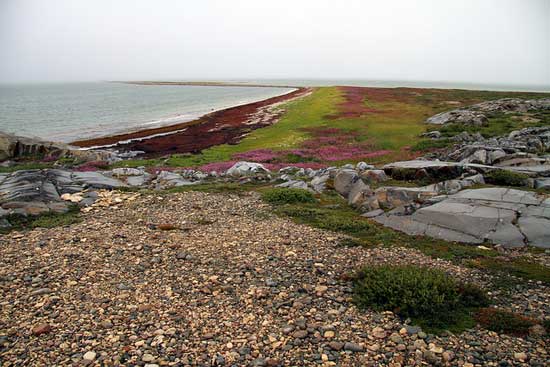
In Winnipeg, it is snowing already. We cram into a chartered prop plane that says on its side that it is run by “Calm Air.” As advertised, the atmosphere under our wings is tepid for about an hour. Then there are bumps. And, slightly further north, some drops.
Soon we are ski-jumping at thousands of feet up. After a dip, I make a grab for my cup of juice. I’ve got it, but the liquid inside goes wild. It leaps up on its own then collapses in my lap.
I try to distract myself with the in-flight magazine. “Winter Living,” teases the cover. “Cure your cabin fever. Cook up comfort food. Check out our cool cold-weather clothes!”
I decide it’s going to be a very long ride.
Churchill, I discover, is a scattering of streets and insulated sheds, but it is right where polar bears arrive each fall in late October and early November to wait for Hudson Bay to freeze. As soon as it does they pad out onto the ice for winter hunting of seals.
Tundra, tundra everywhere. Our guide up here, a German named Matthias, tells us that “tundra” is the land that doesn’t have any trees and that the patches with scraggly forest are called “taiga.”
Did someone say forest? You can spot a few toothbrush-thin spruce trying to grow. But mostly there is wind and snow and a kind of distant cousin of daylight. I check my watch: 1:43 pm. This can’t be right.
Instead of a sun, someone has screwed a Soft White bulb into the sky. And they’ve stuck it in just over the horizon. According to this, it should not be earlier than 5:00.
On the ride from the airport we tourists shout and point. Three shapes that look like pictures in calendars plod along right by the side of the road. We are amazed. It is a mother bear and cubs. Lens caps are dropped, windows on the bus are ajar, and shutters snap and snap.

These are not zoo bears. Not at all. Their fur is puffy, not yellowish or matted. And while the cubs are shy, their mom is confident in a way that’s not easy to describe. She leads the pack, she scans, but she’s not wary like other animals I have watched in the wild.
The cubs are toddler princes. She is the white queen.
We are in her world now, and it is we who unload our bags into a kind of cage. Our home for five days will be a specially-built movable tundra lodge: four train-style cars linked together and jacked up on fat ATV wheels. We’re high enough for safety, but it feels like any cub could hop up onto our decks.
Our sleeping car is toasty thanks to an industrial-strength iron stove set up in an alcove that is whistling while it throws us heat. Each of us gets a private compartment that’s about the size of first class berths on Amtrak: there’s an upper and lower bunk, a window, and some hooks and cubbies to stow your gear.
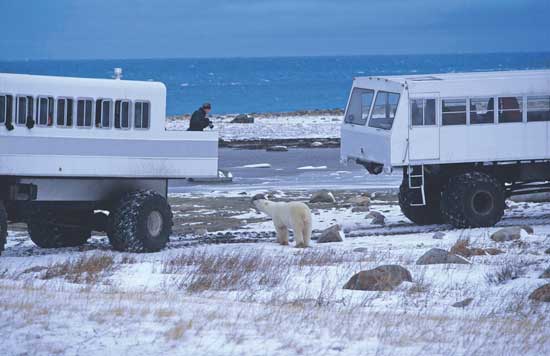
First things first: I strip off my boot socks and drape them near the stove. I do the same with my hat.
“My ears are ice,” complains Roberta Bakos, who tells us she lives in the south. “Miami,” she says. “Miami Beach!”
I should be sympathetic, but I’m not. My toes have been dead since Winnipeg. Now they are itching from the warmth and from the wool of the socks.
I rub and stamp. Jump and scratch. I refuse to move from the stove.
Besides our Pullman bunkroom, the tundra train has cars for lounging and dining. It has between-car decks with railings and steel mesh gratings. And it has bears.
Bears licking the tires under the lodge. Bears snuffling inches from our shoes out on deck. Bears growling and arguing. And bears staring up the open drains when you are trying to get clean.
When I take a shower, I look down while pouring shampoo and see a medium-sized male watching carefully from below. I am embarrassed. But the bear is not.
I rinse off some soap. He rears up closer to the drain. I run the water hot. He shows me his nose and teeth. I crank the knob for pressure, pour it down as hard as it will go. His tongue comes out, just slightly. It flaps. He smacks it. He is having a drink.
Time to towel off.
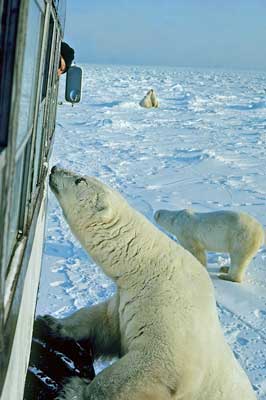
Our welcome dinner is a type of seafood stew. It’s just the thing for the cold and I find I’m craving beer and chunks of butter and bread. Someone notices that a pot of something is steaming out on deck. One of the cooks is stirring, stirring.
“Is it dessert?” asks Bakos.
It is not. It is a broth with leftover scales and fishbones and shells. “We keep it bubbling for the bears,” explains Matthias. “Of course they like this smell.”
After coffee we get a Matthias briefing. “Well, you see some bears already on the way. You see them outside and under the decks. But do you know what you are seeing?”
We think we do. But we are wrong.
“The male,” says Matthias, “he can weigh two times as much as the Siberian tiger.” I remember the one in my shower. “Of all the species of bear,” he adds, “he is most likely to prey on humans.” I think of my shower bear again.
According to Matthias’s chart, a grown-up male can tip the scales at 800 pounds, 1000 pounds, even 1,500. Is this a mistake? He points to the chart. “The polar bear,” he says, “is big. It is sometimes nine, sometimes nine-and-one-half feet long.”
When other facts like this pop out, people start scribbling notes.
*Female polar bears are only about half the size of males. But, when they’re pregnant, they get fat, doubling their weight.
*A polar bear’s skin isn’t white, it’s black. (This causes frowns.)
*If you try to take an infrared shot of a polar bear, good luck. They’re so well insulated, they’re invisible in infrared—except for their breath.
*And, yes, polar bears are in trouble. They swim from ice floe to ice floe. And with so much ice melting off, they’ve had to swim further–often struggling, sometimes drowning–in their push to find food.
Our bears are still on land where they are safe and where we can meet them. Every night they cluster around to smell our stew. To stare in our showers. And to have their squabbles—private disagreements–in the dark.
When it gets late we stop looking down for a little while and look up. At Northern Lights–a glow-in-the-dark Frankenstein green.
Every day, we pile into a sort of moon-buggy to ride away from the lodge in search of yet more bears. The buggy is cold, and we get bitten by an arctic wind that whistles with the zest of the disturbed.
Someone shouts about a snowy owl they can see. Maybe it’s a rock, I say. It is probably an owl, decides our guide. When it swivels its feathery head we know for sure.
Seconds later we spot an arctic fox that pops up and disappears behind a bank of snow. He is whiter than the white of the landscape, and surprisingly small. My cat, Sam, outweighs him by a good five pounds, but this fox is fast—trotting and darting until he is gone.
Our last day of the tour is spent in town and we are warned that there can be bears in Churchill, too.
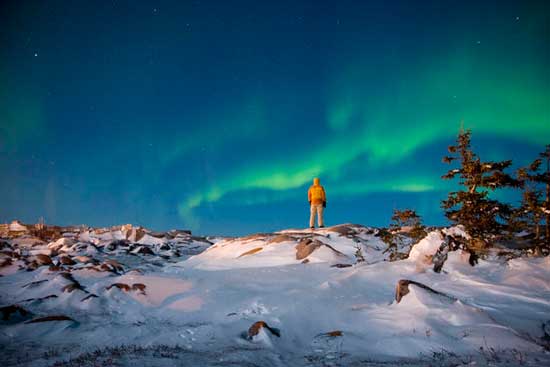
“It isn’t good,” says a local guide we meet here, “but before we closed it, they would come to have some dinner at the dump.”
“Bears are aggressive, adds Matthias, “and they are sometimes creative. They eat plastic, styrofoam, entire bags of garbage—that’s including the bag. Anything people throw away.”
The last time anyone got mauled here was in 1983, we are told. For reasons no one can explain, a local man went for a walk at night with jacket pockets filled with meat. A polar bear ate him and the pocketed meat as a single meal.
None of this is reassuring, and we look carefully around corners and spend a lot of our time inside bars and stores. “At least,” says Roberta Bakos, who is buying a statue of an arctic walrus, “it means there are still enough of the bears for us to have to worry.”
“Still enough,” agrees Matthias. “To do what polar bears do.”
I’m glad to hear it. But when I go to the edge of Churchill to take pictures, I look carefully around.
Aggressive Churchill bears end up locked inside a former military hangar. And now and then, on crisp and clear afternoons, they are given an extraordinary dose of something to relax them and helicoptered far from town.
Before our tour group heads to the airport, we get to see a deeply slumbering bear as he is stretched out into a hammock-like net, winched up by the copter, and swung up high and swaying, into the blue-black arctic dome.
“Calm Air,” is what I say to myself. Calm air.
The bear and I—both—are flying peacefully today.
We are going home.
Author Bio: Peter is an author of books for children including Jackhammer Sam (Macmillan) and Bun, Onion, Burger (Simon & Schuster). A regular travel contributor to The Washington Post and The Boston Globe, I’ve written for Harper’s, The Wall Street Journal, The International Herald Tribune, and The Los Angeles Times. One of my Globe articles won the 2005 Lowell Thomas gold award from the Society of American Travel Writers for adventure travel article of the year. Other articles, for The Washington Post and The Baltimore Sun, won Lowell Thomas Awards in 2003, 2006 and 2007.
- Top 10 Things to Do in Ireland - April 25, 2024
- How to Get Around in Sydney: A Local’s Guide to Traveling Around Sydney - April 24, 2024
- The Low-Key Magic of Ghent, Belgium - April 22, 2024
